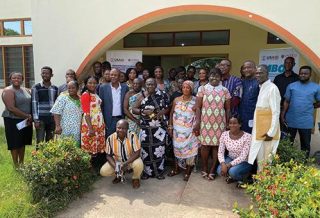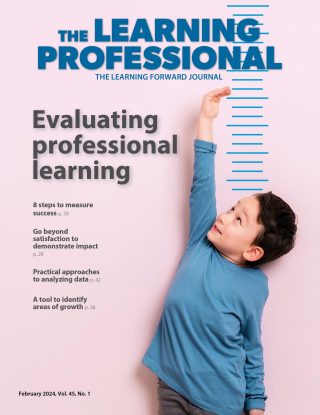FOCUS
Professional learning for a virtual world
By Michelle Bowman
Categories: Continuous improvementOctober 2021
In March 2020, emergency school closings as a result of the COVID-19 pandemic initiated a sudden widespread use of virtual learning and brought new challenges that affected teaching and learning across multiple contexts.
The complex change caused school district leaders to make plans to reinvent and reimagine schools (Transcend, 2020) and created a need for teacher professional learning on effective techniques for teaching remotely (Lieberman, 2020).
An effective professional learning system is essential to improving teaching and learning in this and all contexts and removing inequities in students’ access to opportunities that lead to their success as productive adults and citizens (Hirsh & Brown, 2018). Facilitating these complex changes and supporting leaders to build equitable systems requires transformation at every level of the education system (Learning Forward, n.d.).
''An effective PL system is essential to improving teaching & learning in this & all contexts & removing inequities in students’ access to opportunities.'' #TheLearningPro Share on XAs education leaders around the world faced the same problem, Learning Forward responded with a deliberately designed community of practice to facilitate community learning and shared problem-solving (Wenger et al., 2002). The community of practice, called Design Professional Learning for a Virtual World, enables members to share expertise, resources, and knowledge, pursue a common purpose, and learn from one another.
I studied the community of practice model and found that when school district leaders engaged and collaborated in the community of practice specifically focused on designing and implementing a comprehensive professional learning system, their professional learning knowledge, skills, and leadership behaviors changed significantly (Bowman, 2021). They learned more, collaborated more effectively, and became more proficient in leading professional learning.
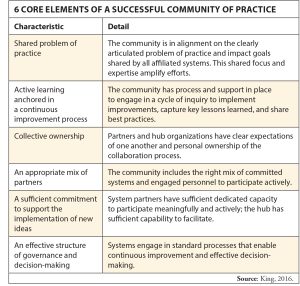
About the network
The Design Professional Learning for a Virtual World network built on Learning Forward’s history of and expertise in leveraging networks and communities to support improvement in school systems and education agencies.
In 2015, Learning Forward established a model for interdistrict collaboration in a community of practice, building on Wenger’s (1998) community of practice framework as well as the Standards for Professional Learning (Learning Forward, 2011). Through that work, we identified six core elements for a successful community of practice in education (see table above; King, 2016), which served as the foundation for the Design Professional Learning for a Virtual World network.
The network included district and state teams, addressing their current challenges related to the design, implementation, and measurement of professional learning in virtual and digital models. A team of Learning Forward staff and consultants facilitated members’ learning through virtual convenings, customized coaching, resources, and organizational management tools.
The work occurred in three stages: supporting ongoing success in virtual and hybrid learning environments, responding to maximize learning during the school year, and reinventing professional learning to acknowledge and embrace new learning models.
Participating teams created contextualized, comprehensive professional learning plans focused on outcomes, with solutions aligned to district/province and state strategic plans that work across departments.
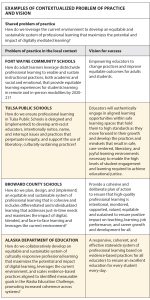
The network’s shared problem of practice centered on leveraging the current environment to develop an equitable and sustainable professional learning system that maximizes the potential and impact of digitally mediated learning. After confirming the shared problem of practice, each team described the problem in its local context, then used common templates and protocols to set a vision for success. The vision established the desired future state to ensure equity through innovative professional learning strategies. (See table at right.)
Next, each team assessed the status of the professional learning system against the intended future state. The analysis used four focus areas: coherence and relevance, ensuring equity, measuring impact, and virtual environment and resources (see figure). Then the team set goals to include in the professional learning plan.
The goals aligned to district and state strategic plans and intended to increase capacity to create policies and practices for effective professional learning with sustainable solutions that work across departments. For each goal, the teams identified milestones and metrics to measure use, change, implementation, and impact. In the last step, teams drafted short-term activity plans.
Throughout the process, the community of practice design engaged the team members as collaborators and critical friends. Teams shared lessons learned from the emergency shift to virtual and digitally mediated educational models and used them to inform the improvement of the professional learning system.
The collaboration between like-minded state and district leaders facilitated understanding how short-term lessons from the pandemic can inform long-term professional learning plans and support building a contextualized, comprehensive professional learning plan.
District and agency teams consolidated their work through the network into a comprehensive professional learning plan that can serve as the basis for future professional learning. The plans outlined teams’ sustainable solutions to immediate challenges and a professional learning infrastructure that transcends the 2020-21 pandemic. Examples of the comprehensive professional learning plans are available on the Learning Forward website learningforward.org/networks/virtual-design/).
Study design
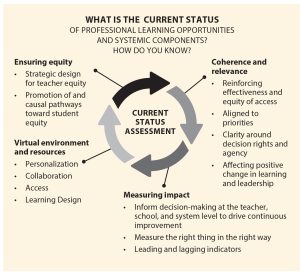
I studied school district leader engagement and collaboration in the community of practice to examine whether leaders’ individual learning and professional learning efficacy changed. The study focused on three research questions:
- What is the relationship between the three dimensions of a community of practice identified by Wenger (1998) and individual school district leaders’ learning? (See box below for information on the dimensions.)
- Do school district leaders’ perceptions of those dimensions change after community of practice participation?
- Does school district leaders’ professional learning efficacy (knowledge, skills, and leadership behaviors) change after community of practice participation?
The quantitative study used a survey design that focused on members who were school district leaders. Of the 42 members, 35 were eligible for the study. They completed a 20-item survey in December 2020, near the beginning of the learning cycle, and in May 2021, at the end of the cycle.
The survey assessed participants’ level of agreement with statements about the community of practice dimensions (shared repertoire, joint enterprise, and mutual engagement) and their agreement with statements about their individual learning. The survey also assessed participants’ community of practice experience (Resources for Learning, 2016, 2017) and professional learning efficacy as defined by knowledge, skill, and leadership behaviors about professional learning (Hirsh & Brown, 2018; Killion, 2013a, 2013b; Learning Forward, 2011, 2013).
Study findings
Analysis revealed that community of practice organization and structure positively impacted school district leaders’ participation, engagement, learning and professional learning efficacy. Here are specific findings.
Recent analysis reveals that community of practice organization & structure positively impacts school district leaders’ participation, engagement, learning, & PL efficacy. @mibowmanpd Share on XThere was a significant correlation between shared repertoire, joint enterprise, mutual engagement, and school district leaders’ learning. School district leaders who believed the network embodied those three dimensions of a community of practice learned more. For example, the cooperative interactions and knowledge sharing spurred collective action. School district leaders partnered for a common purpose and learned innovative ideas and practices to design and implement a professional learning system.
The community of practice provided a beneficial structure and environment for interdistrict collaboration. The community of practice design enabled school district leaders to come together to solve a problem they cared about (King, 2016; Wenger, 1998). Over time, network members became more aware of one another’s competence. They engaged in challenging conversations and participated in facilitated interactions such as critical friends protocols, offering and receiving feedback on work such as goals and milestones.
Leaders’ learning and professional learning efficacy changed after community of practice participation. School district leaders increased their knowledge about their roles and responsibilities to ensure effective, efficient, and equitable professional learning for all educators. They also reported that they developed their own and others’ capacity to lead, advocate, and create support systems for professional learning (Learning Forward, 2011).
Overall, the community of practice provided a valuable environment for school district leaders to learn and increase their capability to recognize and implement an effective professional learning system as a key strategy for supporting and sustaining equitable improvements to increase results for all students — even at a time of enormous challenges and rapidly changing learning conditions.
A @LearningForward community of practice provided a valuable environment for school district leaders to learn & increase their capability to recognize & implement an effective PL system. Share on XThe interdistrict collaboration in the community of practice provided leaders with like-minded thought partners facing similar challenges who, together, built their capacity to address immediate challenges with sustainable solutions that can impact teaching and learning for the long term.
Click here to download pdf.
Participants in the Design Professional Learning for a Virtual World Network
The Design Professional Learning for a Virtual World network had two cohorts.
Teams in the first cohort (September 2020 to June 2021) were from seven school districts and one state education agency: Alaska Department of Education, Broward County Public Schools (Florida), Fort Sam Houston (Texas), Fort Wayne Community Schools (Indiana), Frederick County Public Schools (Virginia), Miami-Dade County Public Schools (Florida), Tulsa Public Schools (Oklahoma), and Stafford County Public Schools (Virginia).
The second cohort began in January 2021 and concludes in December 2021. The school districts include Cobb County Schools (Georgia), Loudon County Schools (Tennessee), Northshore School District (Washington), and Parkway Schools (Missouri).
Each cohort also included a team of Learning Forward Affiliate leaders from the participating states.
3 dimensions of a community of practice
Wenger (1998) identified three characteristics of a community of practice:
- Shared repertoire shows up as routines, words, actions, and concepts that become part of the community of practice.
- Joint enterprise is the common identity and interconnectedness among members.
- Mutual engagement is the collaborative action members use to solve problems.
References
Bowman, M.A. (2021). Learning together: An examination of inter-district collaboration in a community of practice [Unpublished doctoral dissertation]. Baylor University.
Hirsh, S. & Brown, F. (2018). Equity drives Learning Forward’s vision. The Learning Professional, 39(5), 8-10.
Killion, J. (2013a). Comprehensive professional learning system: A workbook for states and districts. Learning Forward.
Killion, J. (2013b). Professional learning plans: A workbook for states, districts, and schools. Learning Forward.
King, M. (2016). 6 key features of a successful community of practice. JSD, 37(6), 12-14. learningforward.org/journal/december-2016-issue/6-key-features-of-a-successful-community-of-practice/
Learning Forward. (2011). Standards for Professional Learning. Author.
Lieberman, M. (2020, September 24). Rethinking teacher training during COVID-19: Bite-sized digital lessons. www.edweek.org/technology/rethinking-teacher-training-during-covid-19-bite-sized-digital-lessons/2020/09
Resources for Learning. (2016). Redesign professional development community (RPDC) initiative: Interim report: May 2015-2016 [Unpublished report].
Resources for Learning. (2017). Redesign PD Community of Practice end of project report [Unpublished report].
Transcend. (2020, April). Responding, recovering, reinventing: Three jobs that matter for school communities navigating a COVID world. bit.ly/3JobsForSchools
Wenger, E. (1998). Communities of practice: Learning, meaning, and identity. Cambridge University Press.
Wenger, E., McDermott, R., & Snyder, W.M. (2002). Cultivating communities of practice: A guide to managing knowledge. Harvard Business.
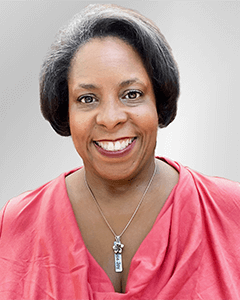
Michelle A. Bowman is senior vice president of networks and continuous improvement at Learning Forward. She engages in and executes cross-organizational strategic thinking, especially through the strategy of networks and communities of practice, that supports state and local education agencies committed to professional development redesign. She also oversees the development of content and learning designs that support organizations' capacity to engage in continuous improvement processes. With 30 years in public education, Michelle served in leadership at the district, campus, and classroom levels before joining Learning Forward. Michelle has an Ed.D. in Learning and Organizational Change from Baylor University. Her dissertation investigated how school district leaders engaging in a community of practice impacts their professional learning efficacy. She also co-authored Teacher Professional Development in the Digital Age: Design and Implementation of Learning without Limits in Technology in the Classroom: How It Can Improve Teaching and Student Learning in American Schools (Rowman & Littlefield, 2017) with Learning Forward Executive Director (retired) Stephanie Hirsh. Michelle refreshes her soul, mind, and body by singing songs of worship and spending time with family and friends. She enjoys great coffee and long walks.
Categories: Continuous improvement
Recent Issues
WHERE TECHNOLOGY CAN TAKE US
April 2024
Technology is both a topic and a tool for professional learning. This...
EVALUATING PROFESSIONAL LEARNING
February 2024
How do you know your professional learning is working? This issue digs...
TAKING THE NEXT STEP
December 2023
Professional learning can open up new roles and challenges and help...
REACHING ALL LEARNERS
October 2023
Both special education and general education teachers need support to help...


